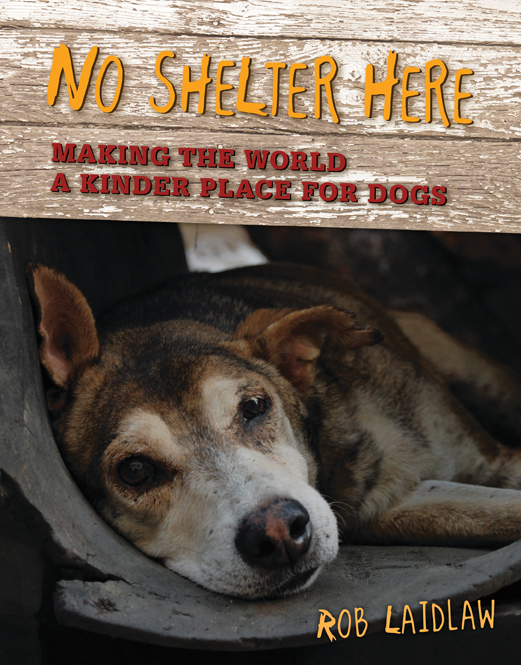| ________________
CM . . . . Volume XVIII Number 11 . . . . November 11, 2011
excerpt:
Even if your budget is tight (whose isn’t?) you will still want to find the money to purchase No Shelter Here which is so much more than just another dog book. This book is a wonderful tool to empower your students to make the world a better place while getting covered in loving dog slobber and wet nose kisses. Who can resist that? Canadian author Rob Laidlaw has a long history of campaigning to protect the animals with which we share the world. According to his website, Laidlaw is a chartered biologist, avid outdoorsman, cave explorer, and a founder of the wildlife protection organization Zoocheck Canada. Previous books by Laidlaw have focused on the plight of animals used in the entertainment world, On Parade: The Hidden World of Animals in Entertainment (reviewed in CM Magazine, Vol XVII, No. 29, April 1, 2011), and animals in zoos, Wild Animals in Captivity (reviewed in CM Magazine, Vol XIV No. 21, June 13, 2008).In No Shelter Here, Laidlaw turns his attention to the animal often referred to as ‘man’s best friend’, and he explains how we can do our part to be a better friend. In his introduction, Laidlaw points out that, in addition to the world of dogs that we are familiar with, there is much that we may not know. No Shelter Here is not just a book about dogs. Laidlaw’s stated purpose is to educate and then motivate the reader to take action to become a ‘dog champion’. Citing examples of people from around the world who have made a commitment to improve the life of dogs, Laidlaw clearly demonstrates that anyone can make difference. No Shelter Here is divided into eight chapters plus an introduction by Laidlaw. Topics include information about dogs’ basic needs, puppy mills and breeding, street dogs, bad jobs for dogs, shelters, and dog champions – people who have made a difference to the lives of dogs. Laidlaw treads a fine line but never crosses over it into being didactic or preachy. He informs and encourages without blaming. For example, after explaining about the conditions that puppy mill dogs live in, Laidlaw talks about breeders. Laidlaw then explains what to look for if you go to a dog breeder’s home or kennel, and where to go if you need advice about ‘who the responsible breeders are’. In a sidebar to this section, Laidlaw refers to the city of Richmond, BC, which “joined a number of other cities by passing a bylaw banning the sale of puppies in pet stores. City councillors said the law will help stop pet stores from buying dogs from puppy mills and backyard breeders.” It is clear that Laidlaw would prefer that people get their dogs from shelters, but he also acknowledges the right to choose a different option and acknowledges that not all breeders are bad. No Shelter Here is well-designed to provide information to junior students in an easily understood format. The many colour photos show many happy dogs and young ‘dog champions’, as well as dogs in less happy situations – caged, chained, homeless. Although the situation is very serious, Laidlaw avoids sensationalizing the message in his book. It is a book meant to empower, not to depress or immobilize. The glossary at the back of the book includes concepts as well as individual words. For example, it includes the distinction between a no-kill shelter – animal shelter that aims not to kill adoptable and treatable animals, but will often not take in sick or untreatable animals – and an open admission shelter – animal shelter that provides care to healthy, adoptable animals, as well as sick or untreatable animals that may have to be put down. The list of websites to visit is extensive and includes both large and small animal protection efforts around the world. Impassioned, empowering and informative, No Shelter Here will fill a void in your dog books collection that you may not have even known you had. In addition to useful information about walking, feeding and grooming your dog, this book encourages the reader to take action to make the world a better place for all dogs. Highly Recommended. Suzanne Pierson is a retired teacher-librarian, currently instructing Librarianship courses at Queen’s University in Kingston, ON.
To comment
on this title or this review, send mail to cm@umanitoba.ca.
Copyright © the Manitoba Library Association. Reproduction for personal
use is permitted only if this copyright notice is maintained. Any
other reproduction is prohibited without permission.
NEXT REVIEW |
TABLE OF CONTENTS FOR THIS ISSUE
- November 11, 2011.
AUTHORS |
TITLES |
MEDIA REVIEWS |
PROFILES |
BACK ISSUES |
SEARCH |
CMARCHIVE |
HOME |
